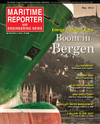
Page 44: of Maritime Reporter Magazine (May 2013)
Energy Production & Transportation
Read this page in Pdf, Flash or Html5 edition of May 2013 Maritime Reporter Magazine
44 Maritime Reporter & Engineering News ? MAY 2013 BRAZILTX2The TX2 channel will be 6.5km long, with a 13km wharf line, a width of 300m, and a 600m maneuvering basin capable of handling the largest OSVs at a depth of between 10.5-18m. The works began in August 2011, and the Þ rst stage was completed at the end of 2012. The channel currently is 4.8 km long, from which 35.7 million cu. m. of sand have been dredged by Dutch com-pany Boskalis.Construction of the breakwater at TX2 started in December 2011. The breakwater?s structure will consist of the north and south ends and will have a length of up to 4km, consisting of 42 concrete blocks and 4.8 million tons of stone. The operation began with Bos- kalis?s vessel Seaway using its dredg- ing equipment to dredge the foundation pits, the Þ rst step for laying the concrete blocks that will form the breakwater. The Kugira, Europe?s largest ß oating dyke, was moored at Porto do Forno in Arraial do Cabo until November 2012, where it produced six concrete blocks. Each block is massive, measur- ing 66.85m long, 24m wide and 18m high. All six blocks built by the Kugira in Arraial do Cabo have been laid at the north end of the breakwater. The Kugira was transported to Açu in November 2012, where it will continue producing the remaining 36 blocks. The provision- al wharf to moor the Kugira has been completed, within the structure of the north end of the breakwater. This is the Þ rst time a breakwater has been built in Brazil using ß oating concrete blocks technology. The TX2 terminal has a total area of 2 million sq. m., slated for the installation of offshore support industries and is set to become a leading support hub for the O&G industry and offshore E&P opera- tions. This location around 150km from the Campos Basin, (which answers for 85% of Brazil?s oil production) and reasonably close to the pre-salt heavy Santos Basin (around 400km to the south) and Espirito Santo Basin (around 250km to the north), may well place it in a position to help solve some of the logistics bottlenecks which are expect-ed to affect the Brazilian O&G industry in the near future. InvestmentsLLX hopes to attract investments of around $26 billion for the port and in-dustrial complex. These investments will come from the company itself and its partners, such as the consortium LLX Minas-Rio which is investing around $15 billion, including investments by Anglo American in a roughly 500km railway line to bring mineral production from the major Brazilian mining state of Minas Gerais to Açu. The LLX Minas- Rio consortium is formed by LLX 51% and Anglo American 49%. LLX Minas- Rio has invested around $500 million in the Açu Superport. According to the contract between the companies, the ad-ditional investment in Açu of around $1.15 billion is being made by Anglo American. Some companies are already installed and building facilities at the TX2, such as Technip, National Oilwell Varco and Intermoor, which together are investing to the tune of $1 billion, while LLX Açu is investing around $3 billion, and partner company OSX will be investing another $4.8 billion, so the targeted total investment is already close at hand. According to Berto, LLX recently signed a joint venture contract with the ASCO Group a leading inter- national Oil & Gas services company. They will occupy a location close to the inland tip of the TX2 channel. Marcus is positive that this will be interesting for both companies and also for the off- shore support companies present at the TX2. Additional deals to solidify the port?s position include: ? In March 2013 , BP Products North America Inc. signed a contract to create the company MFX (Marine Fuels X), to import, export, sell and distribute ma-rine fuels under the BP Marine brand. ? In March 2013 , Wärtsilä rented a 29,300 sq. m. patch along the TX2 channel. Wärtsilä will install a facility to assemble and produce gensets and propulsion products, in addition to of-fering solutions and services to its cli-ents for the marine propulsion and en-ergy sectors. ? On November 28, 2012 , GE do Brasil signed a contract entailing the construction of a GE industrial plant in the landside area of Açu Superport. To be located in the metal works cluster of the Industrial Complex, GE?s manufac- turing facility will have a total area of up to 322,489 sq. m., primarily to serve the oil and gas and power generation sectors. ? On December 19, 2012 , V & M do Brasil signed a deal for the construction of a logistics base in the landside yard of Açu Superport. V & M?s plant will serve oil companies operating in the Campos Basin, offering Just-in-Time storage and supply of pipes and special-ist services. The logistics base will be located in the metal works cluster of the industrial complex and will occupy a to-Aç u location in relation to O&G basins. Workers at OSX quay in the TX2. (Photo Claudio Paschoa)(Image LLX)Marcus Berto, CEO, LLX (Image LLX)MR #5 (42-49).indd 44MR #5 (42-49).indd 445/2/2013 9:51:07 AM5/2/2013 9:51:07 AM

 43
43

 45
45
